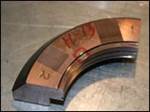How to Choose the Right Welding Option
When comparing microscopic laser welding and microscopic TIG welding, both have distinct advantages and disadvantages.
In the world of micro welding, a controversy rages over whether the upcoming rise of microscopic laser welding will replace microscopic TIG welding as the preferred method for tool repair. On one hand, some laser producers say that lasers will replace micro TIG because laser welders produce a superior weld and the learning curve for the operation is a matter of weeks versus a matter of years. On the other hand, if one asks the majority of top micro TIG welding shops, they will say that lasers only can be used for a small percentage (1 percent to 5 percent) of their current work and that buying a laser isn't worth the investment. So who is telling the truth?
In considering laser welding for tool repair versus microscopic TIG, the advantages and disadvantages of each must be brought into consideration. Each has distinct characteristics that suit its specific repair applications.
Microscopic Laser Welding
Microscopic laser welding has some distinct advantages as far as weld quality. Lasers have extremely low heat input during the welding process. Therefore, the heat-affected zone (HAZ) around the welded area is minimal. This is a great advantage when repairing a texture or polished surface. This also produces virtually zero sink around the weld, allowing for an almost undetectable weld after refinishing. Also, a laser beam can be shot deep into cavitation areas, so long as the area allows for at least an approximate fifteen degree included angle weld beam.
Microscopic laser also has distinct disadvantages when it comes to the welding process. A laser head is a fixed unit that is used in conjunction with a microscope to see the area to be welded. This dictates that the workpiece must be manipulated versus a TIG torch. This is not only challenging, but it becomes expensive due to the fixturing of each piece to be welded. Then, the laser application process becomes much slower than micro TIG and, therefore, more expensive. As a result, costs of fixturing tools for a laser welder are more expensive as are the associated costs of the laser (generally anywhere from $30,000 to more than $100,000) and its maintenance.
Microscopic TIG
Due to the proven process of microscopic TIG, it is a well-used, cost effective method for tool repair. Micro TIG weld is typically applied via manipulation of the weld torch by the micro welder, allowing for virtually limitless applications. The speed of the TIG process is far faster than laser for any sizable weld buildup. Sink can easily be held down to tenths of an inch, and cost of equipment and maintenance is a fraction of a laser. Overall, the cost of micro TIG for tool repair also is lower, so long as a reasonably priced micro welder is being used.
The disadvantages of micro TIG are mostly due to its requirement for more substantial heat input than a laser welder. The component to be welded must be preheated to defined temperatures (unique to each steel type), which in turn causes a more lengthy post heating and cleaning process. Also, the required heat during the application of the weld is more likely to distort components, especially very small or thin pieces as well as long, round components. Micro TIG leaves more of a HAZ in its wake than a laser welder, which severely limits the ability for the toolmaker to camouflage the weld of a polished or textured area.
Both microscopic laser welding and microscopic TIG welding have distinct advantages and disadvantages. With current technology, micro laser welding is not a viable replacement for micro TIG nor can a weld be produced with micro TIG that can replicate the low heat input of a laser weld. Both methods compliment one another and should be used by any well-equipped micro welding house.
Related Content
The Ins and Outs of Hot Runner Temperature Control
A training checklist that explains the why and how of proper hot runner temperature control and system management.
Read MorePredictive Manufacturing Moves Mold Builder into Advanced Medical Component Manufacturing
From a hot rod hobby, medical molds and shop performance to technology extremes, key relationships and a growth strategy, it’s obvious details matter at Eden Tool.
Read MoreThe In's and Out's of Ballbar Calibration
This machine tool diagnostic device allows the detection of errors noticeable only while machine tools are in motion.
Read MoreLaser Welding Versus Micro Welding
The latest battle in finely detailed restoration/repair of mold materials.
Read MoreRead Next
TIG Welding for Mold, Tool and Die Repair
Techniques and intricacies of tool and die welding repair.
Read MoreAre You a Moldmaker Considering 3D Printing? Consider the 3D Printing Workshop at NPE2024
Presentations will cover 3D printing for mold tooling, material innovation, product development, bridge production and full-scale, high-volume additive manufacturing.
Read MoreHow to Use Continuing Education to Remain Competitive in Moldmaking
Continued training helps moldmakers make tooling decisions and properly use the latest cutting tool to efficiently machine high-quality molds.
Read More










_300x250 3.png;maxWidth=300;quality=90)



.jpg;maxWidth=300;quality=90)










